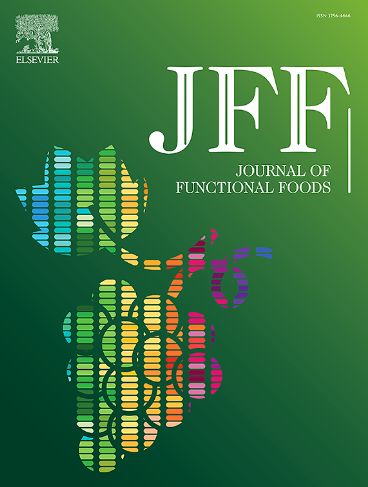在C2C12细胞中,核黄素作为昼夜节律调节剂通过氧化应激和线粒体调节减轻d -半乳糖诱导的肌肉衰老
IF 3.8
2区 农林科学
Q2 FOOD SCIENCE & TECHNOLOGY
引用次数: 0
摘要
骨骼肌衰老的特征是肌源性分化受损、线粒体功能障碍和昼夜节律紊乱,从而导致肌肉减少和肌肉萎缩。本研究研究了核黄素(FAD和FMN的前体)在d -半乳糖诱导的衰老C2C12中对昼夜节律调节、线粒体氧化还原代谢的关键辅助因子以及线粒体功能的影响。d -半乳糖处理损害了肌管的形成,而Ribo 20 μM则恢复了肌管的形成和肌管宽度。Ribo恢复了分化相关基因和核心时钟基因的昼夜节律振荡,这些基因被d -半乳糖减少。Ribo通过调节ROS、MDA、过氧化氢酶和GPx水平减轻氧化应激。Ribo通过增加ATP的产生和线粒体膜电位改善线粒体功能。值得注意的是,Ribo恢复了ATP5A的节律性,突出了其在线粒体功能昼夜节律调节中的作用。核黄素是与年龄相关的肌肉衰退的有希望的候选者,因为它可以恢复肌源性分化,减少氧化应激,支持线粒体功能,保持昼夜节律平衡。本文章由计算机程序翻译,如有差异,请以英文原文为准。

Riboflavin as a circadian modulator mitigates D-galactose-induced muscle senescence via oxidative stress and mitochondrial regulation in C2C12 cells
Skeletal muscle aging is characterized by impaired myogenic differentiation, mitochondrial dysfunction, and circadian rhythm disruption, which contribute to sarcopenia and muscle atrophy. This study investigated the effects of riboflavin, a precursor of FAD and FMN, on circadian rhythm regulation, a crucial cofactor in mitochondrial redox metabolism, and mitochondrial function in the D-galactose-induced aging C2C12. D-galactose treatment impaired myotube formation, whereas Ribo 20 μM restored myotube formation and myotube width. Ribo restored the circadian oscillations of differentiation-related genes and core clock genes that were reduced by D-galactose. Ribo alleviated oxidative stress by regulating ROS, MDA, catalase, and GPx levels. Ribo improved mitochondrial function by increasing ATP production and mitochondrial membrane potential. Notably, Ribo restored ATP5A rhythmicity, highlighting its role in the circadian regulation of mitochondrial function. Riboflavin is a promising candidate for age-related muscle decline, as it restores myogenic differentiation, reduces oxidative stress, and supports mitochondrial function, preserving circadian homeostasis.
求助全文
通过发布文献求助,成功后即可免费获取论文全文。
去求助
来源期刊

Journal of Functional Foods
FOOD SCIENCE & TECHNOLOGY-
CiteScore
9.60
自引率
1.80%
发文量
428
审稿时长
76 days
期刊介绍:
Journal of Functional Foods continues with the same aims and scope, editorial team, submission system and rigorous peer review. We give authors the possibility to publish their top-quality papers in a well-established leading journal in the food and nutrition fields. The Journal will keep its rigorous criteria to screen high impact research addressing relevant scientific topics and performed by sound methodologies.
The Journal of Functional Foods aims to bring together the results of fundamental and applied research into healthy foods and biologically active food ingredients.
The Journal is centered in the specific area at the boundaries among food technology, nutrition and health welcoming papers having a good interdisciplinary approach. The Journal will cover the fields of plant bioactives; dietary fibre, probiotics; functional lipids; bioactive peptides; vitamins, minerals and botanicals and other dietary supplements. Nutritional and technological aspects related to the development of functional foods and beverages are of core interest to the journal. Experimental works dealing with food digestion, bioavailability of food bioactives and on the mechanisms by which foods and their components are able to modulate physiological parameters connected with disease prevention are of particular interest as well as those dealing with personalized nutrition and nutritional needs in pathological subjects.
 求助内容:
求助内容: 应助结果提醒方式:
应助结果提醒方式:


